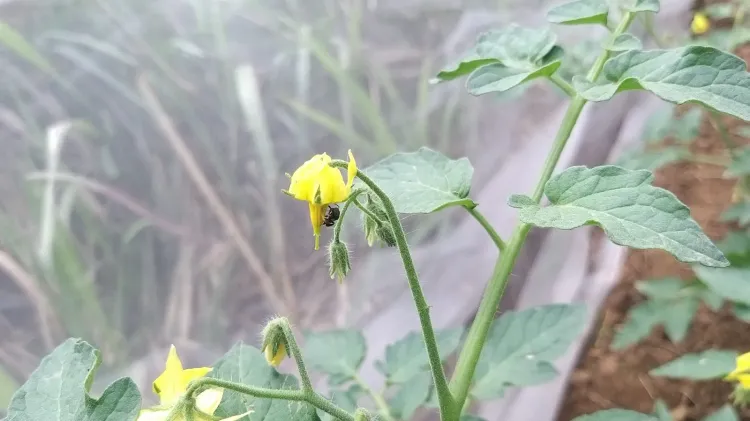Could Stingless Bee Species Discovered by Nagaland University Researchers Enhance Crop Yield and Quality?

Synopsis
Key Takeaways
- Stingless bees are effective pollinators that can significantly enhance crop production.
- The introduction of these bees results in improved crop quality and seed viability.
- They provide an additional source of income through honey production.
- Research on stingless bees has led to better beekeeping practices and conservation efforts.
- Future studies will focus on lesser-known crops and honey extraction techniques.
Kohima, May 26 (NationPress) Researchers from Nagaland University have discovered stingless bee species that can enhance agricultural productivity through pollination, according to statements made by researchers and officials on Monday.
University officials stated that by introducing stingless bees as pollinators for various crops in greenhouse settings, both the yield and quality of the produce saw significant improvements.
The researchers highlighted that stingless bees are capable of pollinating without the risk of stings, and are recognized for their valuable medicinal honey and effective pollination abilities. This breakthrough opens avenues for creating crop pollination calendars, benefiting all involved parties.
Additionally, the honey produced during these experiments offered an extra source of income alongside enhanced crop production.
Findings showed that the chilli crop benefited from pollination by these bees, yielding higher production and superior quality compared to crops that lacked pollination.
To address the pollination gap in chilli, conservation of stingless bees and honeybee species such as A. dorsata, A. florea, as well as wild bees like halictid bees, syrphid bees, and Amegilla bees, is essential. In the case of king chilli, the fruit set rose to 29.46% compared to 21.00% in crops without pollination.
Similarly, in Chilli (Capsicum annuum), the fruit set and quality of fruits increased by 7.42% and 7.92% respectively over non-pollinated crops.
Moreover, seed weight—an indicator of viability—rose by 60.74% when pollinated by stingless bees. This marks the first effort to assess the pollination potential of stingless bees and the quality of honey produced, leading to increased income and sustainable livelihoods.
Using honeybees for crop pollination had previously been challenging due to their natural behavior. This research was spearheaded by Dr. Avinash Chauhan, Scientist and Principal Investigator (AICRP Honeybees and Pollinators), Department of Entomology, School of Agricultural Sciences, Nagaland University.
The findings from his team have been published in multiple esteemed, peer-reviewed journals. Discussing the research, Dr. Chauhan noted, “The results from the last seven to ten years have presented various opportunities for stakeholders to cultivate stingless bees for quality honey production while avoiding contamination and minimizing bee losses, resulting in greater profitability. We continue to refine beekeeping techniques and promote scientific methods for better honey production and crop pollination, while also raising awareness for the conservation of other wild honey bees and pollinators.”
Looking ahead, he mentioned plans to study lesser-known crops like passion fruit, Solanum spp., and Chow Chow, which hold geographic significance.
“We will also focus on extraction techniques for stingless bee honey. The medicinal properties of this honey will be analyzed through proper evaluation and mellisopalynological studies,” Dr. Chauhan added.
This current research concentrates on utilizing stingless bees from the genera Tetragonula spp. and Lepidotrigona spp. for pollinating crops such as cucumber, chilli, king chilli, ash gourd, watermelon, citrus, tomato, pumpkin, brinjal, and dragon fruit.
Colony extraction from forests and fields followed established methods to scientifically multiply the colonies, ensuring a sufficient number for effective pollination in controlled environments.
Their pollination capabilities on Mango, Guava, Rhus, Gooseberry, and Ber were also noted and recorded.
The university researchers reported that stingless bees have been discovered in northeastern India, eastern India, and southern Indian states, with recent additions from northern, central, and western states.
Unlike the nascent stages of stingless bee rearing in several states, traditional practices are still used in homestead apiaries in the northeastern and southern states.
However, in the past 7-10 years, Nagaland has achieved significant advancements in the scientific domestication of these bees, including the development of scientific hives and mass multiplication of colonies using queen cells, which has also been extended to other states like Meghalaya and Arunachal Pradesh.
This progress has facilitated the easy multiplication of these bees for pollination and other bee products. Farmers and stakeholders can now utilize their stingless bee colonies for effective crop pollination in both open field and greenhouse settings, leading to improved yields and quality of produce.









